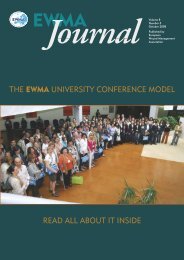best practice for the management of lymphoedema ... - EWMA
best practice for the management of lymphoedema ... - EWMA
best practice for the management of lymphoedema ... - EWMA
You also want an ePaper? Increase the reach of your titles
YUMPU automatically turns print PDFs into web optimized ePapers that Google loves.
Oxerutins have been licensed in some<br />
countries, usually <strong>for</strong> use in chronic venous<br />
insufficiency, but <strong>the</strong>re are insufficient data<br />
to draw conclusions about <strong>the</strong>ir efficacy in<br />
<strong>lymphoedema</strong>. The same conclusion has<br />
been reached about flavonoids. Coumarin<br />
has been most widely trialled, but <strong>the</strong> most<br />
recent study reported no significant effect 95<br />
and <strong>the</strong> drug has been withdrawn in<br />
Australia because <strong>of</strong> liver toxicity.<br />
Diuretics<br />
Diuretics encourage <strong>the</strong> excretion <strong>of</strong> salt and<br />
water, and by reducing blood volume might<br />
be expected to reduce capillary filtration and<br />
lymph <strong>for</strong>mation. There is no evidence that<br />
diuretics encourage lymph drainage.<br />
A diuretic is likely to be prescribed on a<br />
pragmatic basis <strong>for</strong> anyone with oedema<br />
almost irrespective <strong>of</strong> cause. However,<br />
higher doses <strong>of</strong> thiazides or loop diuretics<br />
(eg furosemide or bumetanide) can reduce<br />
body potassium levels with long-term use<br />
and may cause muscle weakness, promote<br />
oedema <strong>for</strong>mation and affect <strong>the</strong> heart.<br />
Diuretics are not recommended <strong>for</strong> use in<br />
<strong>the</strong> treatment <strong>of</strong> <strong>lymphoedema</strong>. Occasionally,<br />
short courses may be <strong>of</strong> benefit in chronic<br />
oedema <strong>of</strong> mixed aetiology, and in older<br />
patients in whom enhanced lymphatic<br />
drainage as a result <strong>of</strong> <strong>lymphoedema</strong> <strong>the</strong>rapy<br />
precipitates cardiac failure.<br />
BREATHING EXERCISES<br />
Breathing exercises are recommended by<br />
some clinicians as a preliminary manoeuvre<br />
that may help to clear <strong>the</strong> central<br />
lymphatics prior to interventions that<br />
promote lymph drainage from <strong>the</strong><br />
peripheries 97 . However, o<strong>the</strong>r clinicians<br />
question <strong>the</strong> physiological basis <strong>of</strong> breathing<br />
exercises as <strong>the</strong>re are no experimental data<br />
in humans to confirm that variations in<br />
intrathoracic pressure due to breathing<br />
assist central lymphatic drainage into <strong>the</strong><br />
venous system.<br />
Although a recent human study<br />
demonstrated that a combination <strong>of</strong> exercise<br />
and deep breathing significantly reduced <strong>the</strong><br />
volume <strong>of</strong> <strong>lymphoedema</strong>tous limbs 79 ,<br />
evidence is lacking <strong>of</strong> <strong>the</strong> effect <strong>of</strong> breathing<br />
exercises in isolation. None<strong>the</strong>less, breathing<br />
exercises are not harmful, are inexpensive,<br />
and may be proven beneficial in some groups<br />
<strong>of</strong> patients with <strong>lymphoedema</strong>.<br />
LYMPHOEDEMA TAPING<br />
Lymphoedema taping is an emerging <strong>for</strong>m <strong>of</strong><br />
treatment <strong>for</strong> <strong>lymphoedema</strong>. It involves <strong>the</strong><br />
application <strong>of</strong> narrow strips <strong>of</strong> elastic tape to<br />
<strong>the</strong> affected area, and can be used in<br />
combination with compression garments or<br />
bandaging. It is thought to improve muscle<br />
function and lymph flow 98 and may have a<br />
role to play in <strong>the</strong> treatment <strong>of</strong> midline and<br />
peripheral swelling. However, evidence is<br />
lacking <strong>of</strong> its efficacy in <strong>lymphoedema</strong>.<br />
HYPERBARIC OXYGEN<br />
Hyperbaric oxygen <strong>the</strong>rapy is known to<br />
promote healing in bone that has become<br />
ischaemic following radio<strong>the</strong>rapy. In patients<br />
with upper limb <strong>lymphoedema</strong> following<br />
radio<strong>the</strong>rapy, two small studies have<br />
indicated that hyperbaric oxygen may<br />
improve lymph flow and reduce limb volume<br />
in <strong>the</strong> short-term 99,100 . Fur<strong>the</strong>r research is<br />
required to establish whe<strong>the</strong>r benefits can be<br />
demonstrated in randomised trials and in <strong>the</strong><br />
long-term.<br />
LASER THERAPY<br />
Low level laser <strong>the</strong>rapy has shown potential<br />
<strong>for</strong> <strong>the</strong> treatment <strong>of</strong> <strong>lymphoedema</strong>,<br />
particularly <strong>of</strong> <strong>the</strong> upper limb, where it has<br />
reduced limb volume and tissue hardness 101 .<br />
Fur<strong>the</strong>r research is required to establish <strong>the</strong><br />
benefits <strong>of</strong> treatment and <strong>the</strong> optimal<br />
regimen.<br />
OTHER TREATMENTS<br />
BOX 39 O<strong>the</strong>r treatments<br />
O<strong>the</strong>r treatments that have<br />
been used <strong>for</strong> <strong>the</strong> treatment<br />
<strong>of</strong> <strong>lymphoedema</strong>, mainly in<br />
breast cancer patients, that<br />
all require fur<strong>the</strong>r evaluation,<br />
include:<br />
■ cryo<strong>the</strong>rapy<br />
■ transcutaneous electrical<br />
nerve stimulation (TENS)<br />
■ pulsed magnetic fields,<br />
vibration and hyper<strong>the</strong>rmia<br />
■ <strong>the</strong>rmal <strong>the</strong>rapy<br />
■ ultrasound<br />
■ complementary medicine<br />
RECOMMENDED READING<br />
■ Badger C, Preston N, Seers K, Mortimer P. Benzo-pyrones <strong>for</strong> reducing<br />
and controlling <strong>lymphoedema</strong> <strong>of</strong> <strong>the</strong> limbs. Cochrane Database Syst Rev<br />
2004; 2: CD003140.<br />
■ Badger C, Preston N, Seers K, Mortimer P. Physical <strong>the</strong>rapies <strong>for</strong><br />
reducing and controlling <strong>lymphoedema</strong> <strong>of</strong> <strong>the</strong> limbs. Cochrane Database<br />
Syst Rev 2004; 4: CD003141.<br />
■ Badger C, Seers K, Preston N, Mortimer P. Antibiotics/antiinflammatories<br />
<strong>for</strong> reducing acute inflammatory episodes in<br />
<strong>lymphoedema</strong> <strong>of</strong> <strong>the</strong> limbs. Cochrane Database Syst Rev 2004; 2:<br />
CD003143.<br />
■ Browse N, Burnand K, Mortimer P. Diseases <strong>of</strong> <strong>the</strong> Lymphatics. London:<br />
Arnold, 2003.<br />
■ European Wound Management Association (<strong>EWMA</strong>). Focus<br />
Document: Lymphoedema bandaging in <strong>practice</strong>. London: MEP Ltd, 2005.<br />
■ European Wound Management Association (<strong>EWMA</strong>). Position<br />
Document: Understanding compression <strong>the</strong>rapy. London: MEP Ltd, 2003.<br />
■ Földi M, Földi E, Kubik S (eds). Textbook <strong>of</strong> Lymphology <strong>for</strong> Physicians and<br />
Lymphedema Therapists. San Francisco: Urban and Fischer, 2003.<br />
■ Lymphoedema Framework. Template <strong>for</strong> Practice: compression hosiery in<br />
<strong>lymphoedema</strong>. London: MEP Ltd, 2006.<br />
■ Olszewski WL. Lymph Stasis: pathophysiology, diagnosis and treatment.<br />
Boca Raton: CRC Press, 1991.<br />
BEST PRACTICE FOR THE MANAGEMENT OF LYMPHOEDEMA 51

















